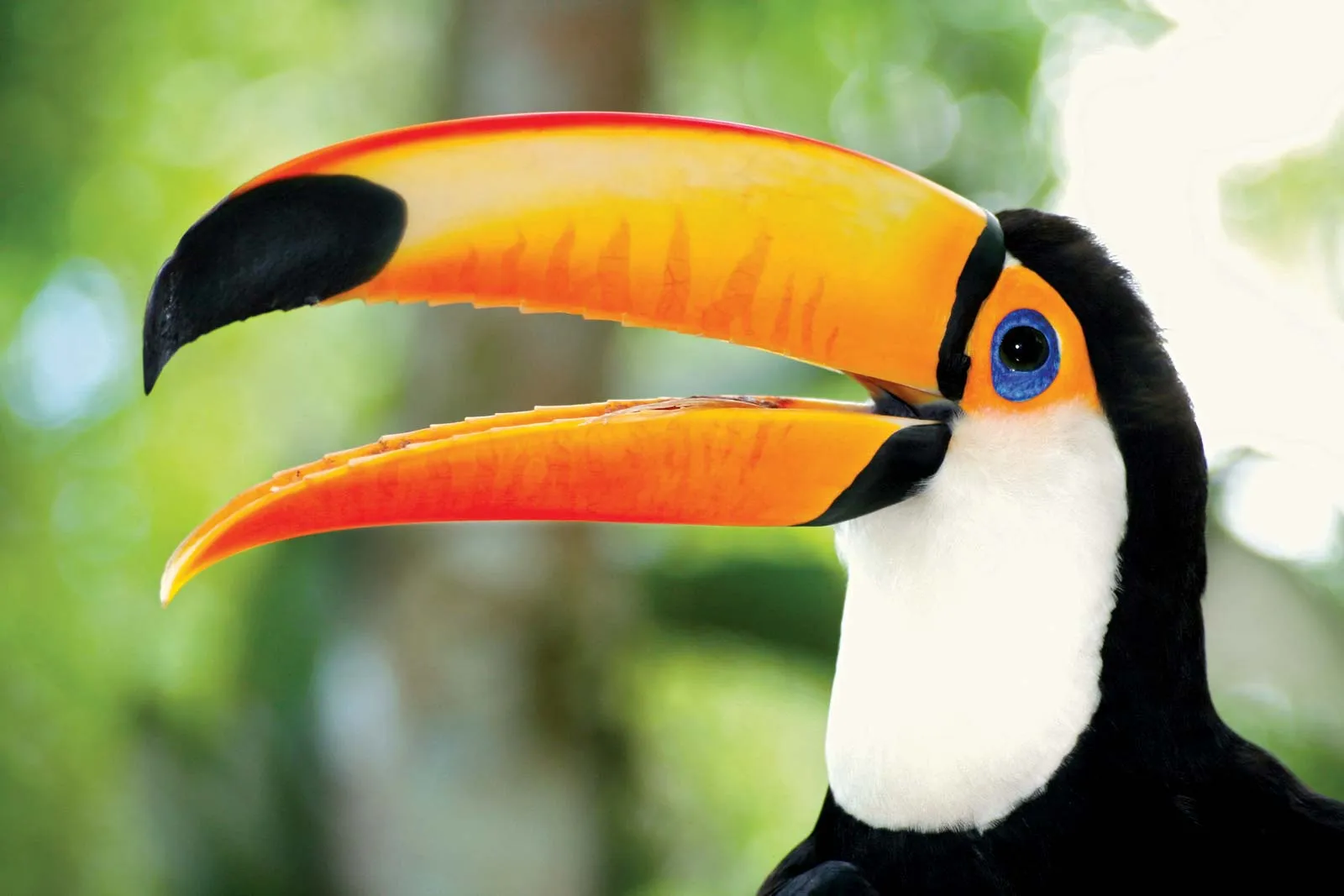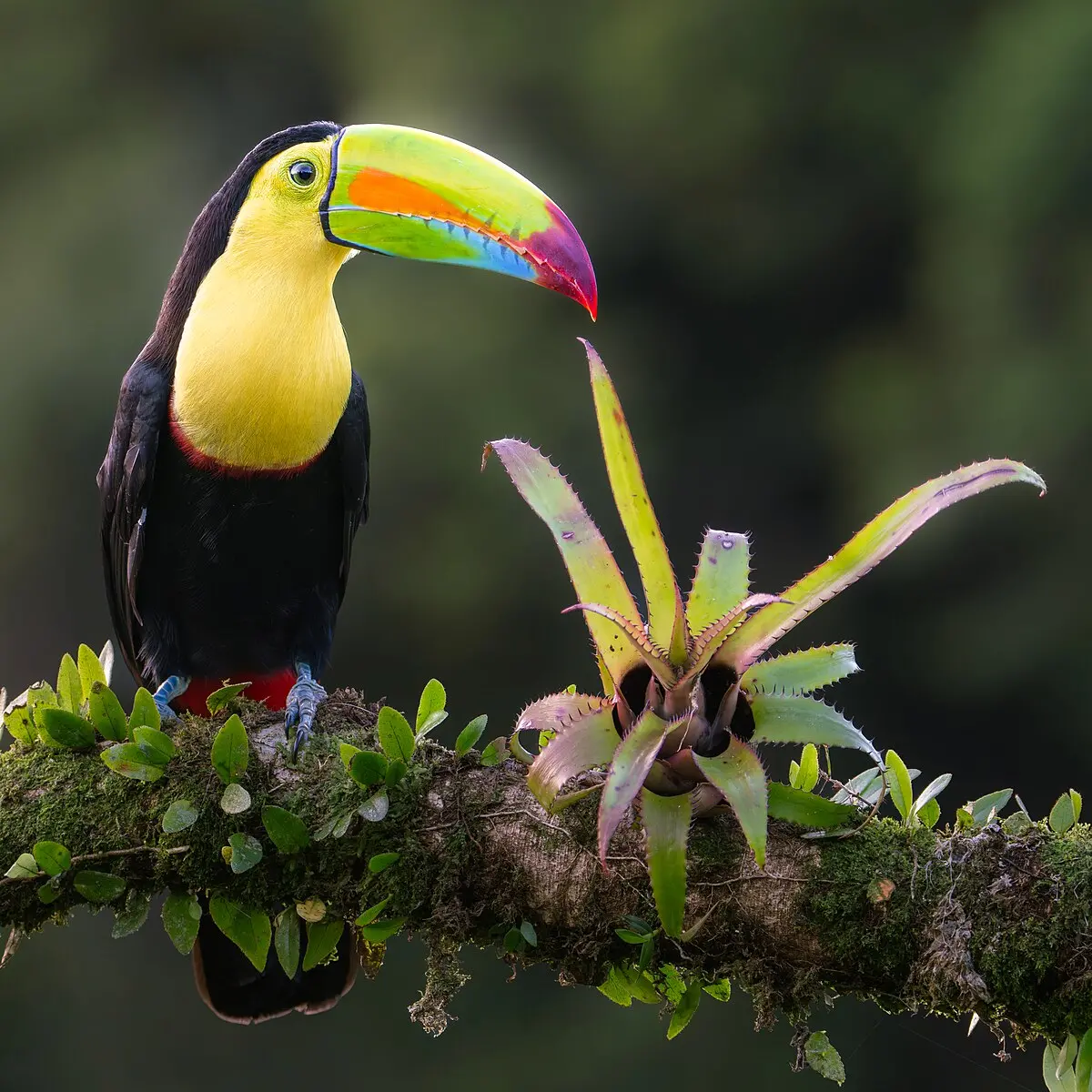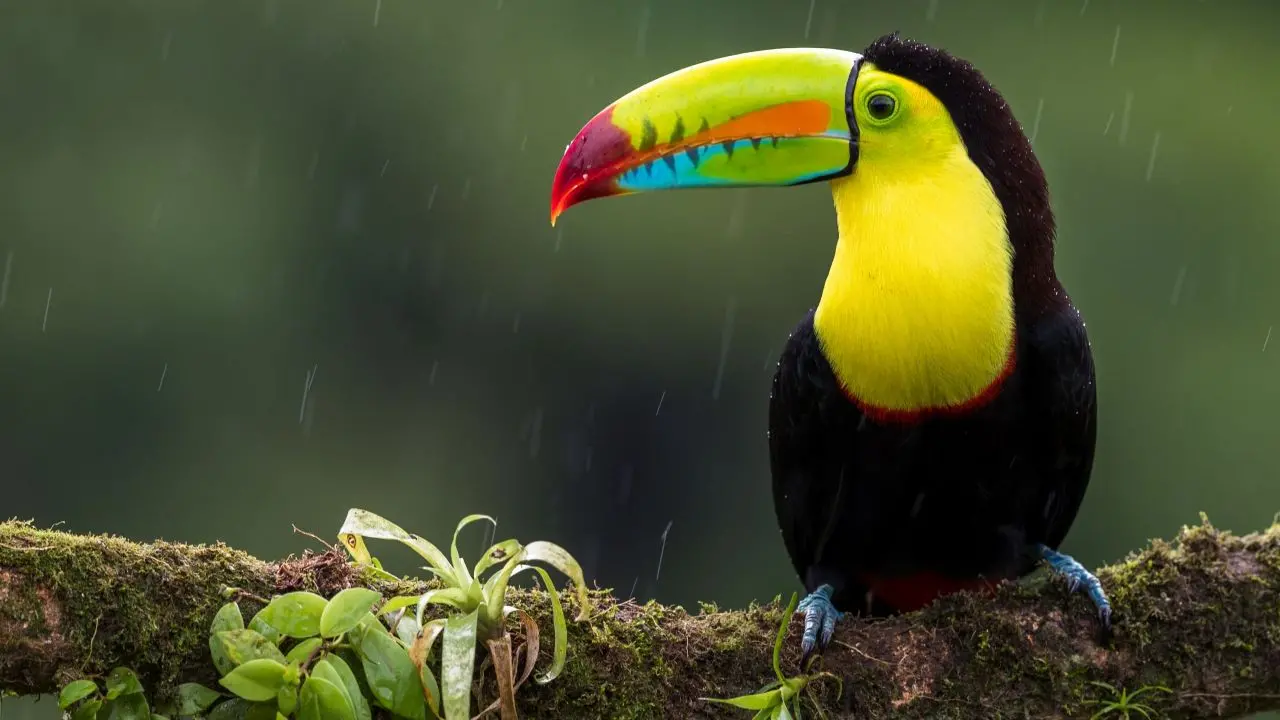Toucan Bird: Exploring Characteristics, Habitat, Diet, Reproduction, and Conservation Efforts
An In-Depth Look at the Toucan Bird's Traits, Habitat, Diet, Reproduction, and the Efforts to Preserve This Iconic Species
Toucans are one of the most captivating bird species found within the tropical rainforests of Central and South America. With their vibrant colors and enormous, striking beaks, they have become iconic symbols of the lush landscapes they inhabit. Their ability to adapt to their environments and unique feeding habits contribute to their ecological importance, as they serve as crucial seed dispersers, supporting the growth and regeneration of various plant species.
This article delves into the multifaceted world of toucans, exploring their characteristics, habitat, diet, reproduction, conservation status, and cultural significance, among other fascinating aspects. Through a comprehensive examination of the toucan’s life, we can appreciate not only the beauty of these brilliant birds but also the essential role they play in maintaining the delicate balance of their ecosystems.
Characteristics of the Toucan Bird
Toucans, belonging to the family Ramphastidae, are well-known for their extraordinary physical features and distinctive traits. The most recognizable characteristic of toucans is undoubtedly their large, colorful beaks, which serve various functional purposes, including feeding and thermoregulation. These birds possess a unique combination of adaptations that make them highly specialized for survival in their native habitats.

- Beak: The beak of a toucan can be as long as its body, serving as a brilliant tool for foraging. Its lightweight, keratin composition allows these birds to manipulate fruits effectively, making it easier to access hard-to-reach food sources. Additionally, the beak assists with thermoregulation, allowing blood flow through its vascular structure to help cool the bird down.
- Size and Weight: Toucans vary significantly in size, with the largest species the Toco toucan reaching lengths of up to 24 inches (61 cm), while smaller varieties like the tawny-tufted toucanet measure around 12.5 inches (32 cm). Their average weight ranges from approximately 3.4 ounces to nearly 1.9 pounds (860 grams).
- Coloration and Plumage: While primarily characterized by black plumage, toucans display vivid hues of yellow, green, red, and orange, contributing to their appeal. The colorful bill oftentimes plays a role in mate attraction and species identification.
- Social Behavior: Toucans are social birds, often found in small flocks. They communicate through various vocalizations and display captivating behaviors, showcasing their striking plumage and unique bills.
This unique combination of features allows toucans not only to thrive in their environments but also to become highly sought after subjects in wildlife photography and ecotourism, further highlighting the importance of their conservation.
Physical Features of Toucan Bird
Toucans exhibit a range of fascinating physical attributes that contribute to their well-known identity in the avian world. These features not only enhance their aesthetic appeal but also play critical roles in their survival strategies.
- Bill: The remarkable bill of a toucan is undoubtedly its most iconic feature. This large beak, comprising a lightweight structure, can exceed the length of the bird’s body, creating a visually captivating appearance. With its varying colors, the bill serves two primary purposes: foraging and thermoregulation. The bill’s design allows toucans to reach and peel fruits that other birds cannot access. In terms of regulating body temperature, blood flows through the vascular structure of the bill, helping to cool the bird down in hot environments.
- Body: Toucans generally have a stout and compact body structure with powerful legs and feet. These adaptations allow them to cling to branches and traverse their arboreal habitat, which is central to their lifestyle.
- Size Variations: With over 40 species of toucans, size varies considerably. The Toco toucan reigns as the largest species, measuring around 24 inches in length with a bill size that can be more than half its body length. Smaller relatives, like the aracaris and toucanets, adapt their size for different ecological niches within the same habitat.
- Plumage: Toucans are adorned with bright and vibrant feather patterns that often include shades of black, yellow, red, and green. These colors serve as both camouflage among the dense foliage of their habitat and means of species recognition, helping mates identify each other, especially during courtship activities.
- Wing Structure: The wings of toucans are relatively short and rounded, somewhat limiting their flight capabilities. When airborne, their wings adapt to gliding rather than long-distance flight, contrasting with the more elongated wings of other birds.
Through these adaptations, toucans illustrate a fascinating evolutionary journey tailored for survival within complex tropical ecosystems. Their striking appearance and specialized features symbolize the rich biodiversity found in the tropical forests they inhabit.
Coloration and Patterns of Toucan Bird Feathers
The coloration and intricate patterns found on toucan feathers are not merely for show; they are reflections of the bird’s evolutionary adaptations and ecological niches. With vibrant plumage that showcases nature’s artistry, toucans present a visual spectacle that is both mesmerizing and thought-provoking.

Toucans are renowned for their bright and vivid feathers, which can range from fiery oranges to deep blues and vibrant yellows. The colors of toucan plumage play multiple roles, significantly influencing their survival.
- Species Variation: Different species exhibit notable color variations. The Toco toucan features a combination of glossy black feathers with a radiant yellow chest and a bill showcasing bold hues of orange and yellow. In contrast, the chestnut-mandibled toucan displays striking combinations of red, yellow, and black, forming a rich tapestry that enhances its appeal.
- Camouflage: One of the most fascinating aspects of their coloration is its dual purpose: it acts as both a camouflage technique and a mating display. While their bright colors may attract mates, these hues can also help them blend into the vibrant environment of the rainforest, protecting them from potential predators.
- Feather Texture: Toucans’ feathers often have a glossy appearance, which is not only visually striking but can also assist in periods of rainfall. The feather structure is designed to shed water efficiently, ensuring the birds remain dry as they navigate through their damp habitat.
- Bill Patterns: The bill patterns exhibit a fascinating organization of colors that can serve a variety of functions, ranging from sexual selection to species identification. The diverse hues and patterns allow for recognition among species and individuals, facilitating mating and social interactions.
By providing a stunning range of colors and patterns, toucan feathers contribute to the overall allure of these birds while serving practical functions essential to their survival in the rainforest.
Habitat of the Toucan Bird
The habitat of the toucan is intrinsically linked to its survival and well-being. Toucans are predominantly found in tropical rainforests, environments bursting with life and rich in biodiversity. Their adaptations to these lush ecosystems make them essential inhabitants and contributors to their surroundings.
- Preferred Environments: Toucans favor lowland tropical forests with abundant food sources, such as fruit-bearing trees. They are predominantly found in Central and South America, particularly in countries like Brazil, Colombia, and Peru. The dense vegetation of these forests provides shelter, protection, and nesting opportunities.
- Canopy Layer: Most toucan species reside in the upper canopy layer of the rainforest. This area provides a plentiful supply of fruits and other food sources while minimizing competition with ground-dwelling species. The arboreal lifestyle allows toucans to utilize their strong legs and feet effectively as they traverse branches.
- Nesting Sites: Toucans typically do not excavate their nests but take advantage of natural hollows in trees or abandoned nests from woodpeckers. This arboreal nesting behavior plays a vital role in protecting their young from predators and harsh environmental conditions found on the forest floor.
The delicate balance of the rainforest ecosystem plays a key role in toucans’ lifestyles. Their presence and interactions contribute to the health and regeneration of the forest, including their important role as seed dispersers. Conserving their habitats is not only crucial for toucans but for the myriad of species that inhabit these unique ecosystems.
Tropical Rainforest Ecosystems
Tropical rainforest ecosystems are complex and dynamic, characterized by rich biodiversity, dense vegetation, and unique climatic conditions. These ecosystems are home to an array of wildlife, including the renowned toucan, which has adapted magnificently to this lush environment.

- Biodiversity and Structure: Tropical rainforests are among the most diverse ecosystems on Earth. They are populated with a variety of species, including trees, plants, mammals, birds, and insects. Toucans thrive in these environments due to the extensive variety of fruit-bearing trees, shrubs, and other vegetation that offer abundant food supplies.
- Climate Conditions: The warm, humid climate of tropical rainforests creates ideal conditions for a plethora of plant and animal life. With consistent temperatures, abundant rainfall, and high humidity, toucans can find shelter and sustenance in their natural habitat year-round.
- Ecological Roles: Toucans, as frugivores, play a crucial ecological role in these ecosystems. Their primary dietary dependence on fruit contributes to seed dispersal, aiding the propagation of various plant species. This mutualistic relationship between toucans and the flora of the rainforest is essential for maintaining biodiversity and forest health.
- Threats to the Ecosystem: Unfortunately, rainforest ecosystems are increasingly endangered due to human activities such as deforestation, agriculture, and urban development. As toucan habitats are destroyed or fragmented, the health of the entire ecosystem suffers, emphasizing the need for conservation efforts.
In summary, tropical rainforest ecosystems provide a rich tapestry of life that supports the vibrant existence of toucans. The interdependence between toucans and their environment highlights the complexity and fragility of these forests, necessitating continued efforts to protect and conserve these critical habitats.
Altitude and Geographic Distribution
Toucans exhibit a notable geographic distribution, closely tied to habitat preferences and altitude. Although primarily associated with lowland tropical rainforests, they display remarkable adaptability that allows them to thrive in diverse ecological niches.
- General Distribution: Toucans are primarily distributed throughout Central and South America, with a concentration in regions containing extensive areas of tropical rainforest. Countries such as Brazil, Colombia, Ecuador, Peru, and Costa Rica offer habitats that support a variety of toucan species.
- Elevation Adaptations: While most toucans are found at low altitudes within tropical rainforests, some species have adapted to higher elevations. For instance, the Andean toucanet has been observed in cloud forests and mountainous regions, demonstrating a surprising versatility in habitat choice.
- Impact of Climate: The specific climatic conditions of a region can significantly influence toucan distribution. Preferences for warm, humid environments typically guide their presence, as these conditions support the growth of the fruit trees that form the backbone of their diet.
- Migration Patterns: Unlike many migratory birds, toucans tend to remain within their native ranges year-round. Their inherent adaptiveness to local food sources allows them to sustain themselves without the need for long migrations, unlike some other avian species.
With varying preferences for elevation and habitat types, toucans exhibit an impressive geographical range. However, with the ongoing threat of habitat destruction, their future distribution may become increasingly fragmented, underscoring the importance of conservation initiatives to safeguard these remarkable birds.
Diet and Feeding Habits
Toucans are known for their diverse diet, which primarily consists of fruits, making them essential components of their environmental ecosystems. Their feeding habits are both fascinating and critical to their survival, as they utilize their unique adaptations to forage in their lush habitats.
- Primary Food Sources: Toucans predominantly consume fruits, with approximately 87% of their diet consisting of various berries, figs, and tropical fruits found in their environment. They are particularly attracted to the fruits of Cecropia trees and palms. Additionally, they incorporate other food sources, such as insects, small reptiles, and eggs from other bird species.
- Feeding Behavior: During the day, toucans forage in pairs or small flocks, using their large beaks to access food in the treetops. Their remarkable dexterity allows them to manipulate fruit and toss it into the air, catching it in their mouths for consumption. This playful behavior fosters social connections within their groups.
- Hydration Needs: In the wild, toucans primarily rely on fruits to provide hydration, but they will also drink water from puddles and natural sources when available. Their specialized digestive system allows them to process fruit efficiently, although they grapple with digesting seeds.
- Adaptability: Toucans display an opportunistic feeding behavior, willing to adjust their diet based on seasonal availability of food. This flexibility helps ensure their survival in ever-changing ecological conditions.
The diet and feeding habits of toucans represent a critical aspect of their role within the rainforest ecosystem. By consuming and dispersing seeds, they significantly contribute to the regeneration and diversity of plant life, showcasing the interconnectedness of all species within their habitat.
Primary Food Sources of Toucan Bird
Toucans’ primary food sources play a crucial role in shaping their daily behaviors and interactions with the environment. They exhibit a notable preference for fruit, but their dietary habits also encompass a diverse array of other food items.
- Fruits: The cornerstone of the toucan’s diet, fruits provide them with essential nutrients and hydration. Common fruits consumed include:
- Figs: High in sugars and easy to consume, figs are a favorite source of nutrition.
- Berries: Toucans enjoy various berries, which are abundant in their habitats.
- Oranges and Guavas: These tropical fruits are critical for their sustenance.
- Cecropia Fruits: This particular food source is a staple, especially during fruiting seasons.
- Insects and Invertebrates: In addition to fruits, toucans incorporate protein-rich insects into their diets, particularly during breeding seasons when they require additional nourishment for their young. Common sources include:
- Beetles: A rich source of protein found in the rainforest.
- Spiders: Occasionally consumed as a protein boost.
- Caterpillars and Larvae: These soft-bodied foods are easier for toucans to digest, especially for feeding chicks.
- Small Animals: On occasion, toucans exhibit opportunistic feeding behaviors, preying on:
- Lizards: Toucans will sometimes consume small reptiles when they are available.
- Bird Eggs and Nestlings: They have been observed raiding nests, emphasizing their adaptability in feeding strategies.
Toucans’ diverse diet plays an integral role in their ecological niche. By promoting seed dispersal through their consumption of fruits, they facilitate the regeneration of tropical foliage, highlighting the significance of their dietary practices in maintaining the health of rainforest ecosystems.
Feeding Behavior and Techniques
Toucans exhibit intriguing feeding behaviors and techniques that allow them to thrive in their natural environments. With their unique adaptations, they have developed specialized methods for foraging and consuming a varied diet.
- Foraging in Social Groups: Toucans typically forage in pairs or small flocks where they can cooperate in locating food sources. This social feeding behavior enhances their foraging efficiency and allows them to communicate information about food availability through vocalizations, showcasing their dynamic interactions.
- Utilization of Beaks: Their large, vibrant beaks are precisely adapted for their feeding needs. Toucans use their beaks to reach fruits that are often out of the reach of other birds. The beak’s design allows for effective manipulation of objects in search of food, often enabling them to pry open tough fruit skins or bark to access tender insects hiding underneath.
- Feeding Techniques: Toucans employ different techniques to consume their food, including tossing fruit into the air to catch it with their beaks. This playful method not only showcases their dexterity but also strengthens social bonds within their groups.
- Digestion Process: Interestingly, toucans generally swallow food whole, relying on their specialized digestive system to break down the contents. They can struggle to digest tougher seeds, but they play a critical role in dispersing seeds through their droppings, allowing for wider plant distribution.
- Hydration Sources: While fruits provide a hydrating source, toucans will also seek out water sources such as small streams and puddles. They have adapted to their environment’s conditions, allowing them to obtain moisture in various ways.
Through these fascinating feeding behaviors and techniques, toucans illustrate remarkable adaptability while contributing to the health and regeneration of their rainforest ecosystems. Their dynamic interactions within social groups enhance not only their feeding efficiency but also the complexity of their environmental relationships.
Reproduction and Breeding
Toucans engage in unique reproductive behaviors that reflect their complex social structures and cooperative parenting. These behaviors play a crucial role in ensuring the survival and growth of their offspring.
- Pair Bonding: Toucans typically form monogamous pairs that may mate for life. Courtship displays begin in spring, highlighted by vibrant plumage displays and vocalizations unique to each species. Males often exhibit exaggerated movements, such as head-bobbing and bill-clapping, to attract females.
- Nesting: Once a pair has formed, they seek out suitable nesting sites in the hollows of trees, often utilizing abandoned woodpecker holes. This soft, safe environment is paramount for protecting their vulnerable eggs from predators and environmental threats.
- Laying Eggs: The female toucan lays a clutch of two to four smooth, white eggs. Both parents share the incubation duties, taking turns to ensure that their eggs are kept warm and secure a cooperative effort that significantly enhances the chicks’ chances of survival.
- Incubation and Rearing: The incubation period typically ranges from 15 to 20 days. Once hatched, the chicks are altricial, born blind and featherless, completely reliant on their parents for food and protection. Both parents actively engage in feeding their young through regurgitation, providing high-nutrient, soft foods necessary for rapid growth.
- Fledging: The fledging period lasts approximately 6 to 8 weeks, during which chicks develop the skills required for survival. After fledging, young toucans remain with their parents for some time before venturing into the wild alone.
By engaging in cooperative breeding and nurturing their young, toucans exemplify distinct social behaviors that enhance the survival rates of their offspring, reflecting their interconnectedness with their environment.
Nesting Habits of Toucan Bird
Nesting habits are a crucial aspect of toucan reproduction, as they directly impact the survival of their young. Toucans exhibit specific preferences and behaviors when it comes to selecting nesting sites and rearing their chicks.
- Nesting Sites: Toucans typically nest in tree cavities rather than excavating their own. They seek out existing holes created by old woodpeckers or natural hollows in trees, which provides protection from predators and harsh environmental conditions. By leveraging these existing cavities, toucans can conserve energy and resources during the breeding process.
- Nesting Material and Structure: The interior of a toucan nest is generally minimalistic, often consisting of a small substrate or none at all. The smooth and secure environment allows the eggs to be kept safe while minimizing disturbance.
- Egg Laying and Incubation: The female usually lays a modest clutch of 2 to 4 glossy, white eggs, which are incubated by both parents. This shared responsibility ensures that the eggs remain warm and protected from threats. The incubation period lasts around 15 to 20 days.
- Parental Care: After hatching, both parents contribute to feeding the chicks, regurgitating soft foods that provide adequate nutrition and foster healthy growth. This level of parental involvement is uncommon in many bird species, showcasing the social structure of toucans as they work together to ensure their offspring’s success.
- Nestling Development: As the chicks grow, they remain in the nest for 40 to 60 days, developing their feathers and gaining strength. During this period, they are vulnerable to threats, but the secure nesting site and dedicated parental care help mitigate risks.
Toucans’ nesting habits reflect their adaptations to their environment, allowing them to effectively care for their young and enhance their survival rates against the backdrop of their vibrant tropical ecosystem.
Egg Laying and Incubation
The egg-laying and incubation process of toucans presents a fascinating aspect of their reproductive strategy. The nurturing behaviors exhibited by these birds are crucial for ensuring the survival and success of their offspring.
- Clutch Size: Toucans typically lay a clutch of two to four eggs, depending on the species. The number of eggs may vary as a response to environmental conditions and the availability of food sources that can sustain the chicks once they hatch.
- Egg Characteristics: The eggs are smooth, glossy, and pure white. Their appearance might not be particularly distinctive, but their structure is important. The eggs are relatively small, averaging about 1.5 inches in length, allowing for a compact nesting arrangement within their chosen cavities.
- Incubation Period: Incubation duration varies among species but usually lasts between 15 to 20 days. Both the male and female share incubation responsibilities, rotating duties to ensure that the eggs are kept safely warm. This level of partnership is indicative of the cooperative nature of toucan social structures.
- Hatching Process: Once the incubation period concludes, the eggs hatch, revealing altricial chicks, which are born blind, featherless, and entirely dependent on their parents. This dependency highlights the vulnerability of newborn toucans and the critical role of parental care during early development.
- Parental Investment: After hatching, the parents actively feed their chicks by regurgitating soft, nutrient-rich food, primarily fruits and insects. This commitment to nurturing lasts for weeks, ensuring the chicks receive sufficient sustenance for healthy growth.
The egg-laying and incubation process in toucans signifies an elaborate reproductive strategy that emphasizes teamwork and dedication. The careful and nurturing methods employed by toucans serve as fundamental aspects of their survival and adaptability.
Conservation Status of Toucan Bird
The conservation status of toucans varies significantly across species, and many face serious threats to their survival. Understanding these challenges is crucial for effective conservation efforts aimed at protecting both toucans and their habitats.
- Species Classification: Of the 41 known toucan species, several are classified according to their conservation status by the IUCN Red List:
- Endangered: The yellow-browed toucanet (Aulacorhynchus huallagae) is currently considered endangered due to habitat loss.
- Near Threatened: Other species, such as the saffron toucanet, plate-billed mountain toucan, and gray-breasted mountain toucan, are listed as Near Threatened, reflecting declining populations and persistent habitat pressures.
- Least Concern: While many species are classified as Least Concern, trends show overall population declines across the toucan family.
- Main Threats: The primary threats to toucan populations include:
- Habitat Loss: Deforestation and land fragmentation pose significant risks. The conversion of rainforests into agricultural areas, primarily due to cattle ranching and crop cultivation, leads to the destruction of nesting and foraging habitats.
- Hunting and Trade: Toucans are hunted for food and are also captured for the illegal pet trade. The demand for toucans as exotic pets contributes to the decline in their populations.
- Climate Change: Alterations in rainfall patterns and temperature shifts threaten the ecosystems that toucans depend on for food and nesting sites.
Conservation status is critical for understanding and planning for the future of toucans. Continued efforts to monitor and protect these birds and their habitats are essential to ensure their survival for generations to come.
Threats to Toucan Populations
Toucans face a multitude of threats that have detrimental impacts on their populations and overall conservation status. Specifically, various human-induced factors combined with natural pressures now jeopardize these remarkable birds.
- Habitat Loss: The most pressing threat to toucans is habitat destruction, particularly due to deforestation in the Amazon basin. Land is cleared for agriculture (especially soy production) and cattle ranching, leading to the destruction of vast areas of rainforest. The loss of primary forest habitat directly impacts toucans by reducing their access to food and nesting sites and increasing competition for limited resources.
- Illegal Hunting: Toucans are hunted in many regions for food, trophies, and the exotic pet trade. This hunting pressure has significantly affected certain populations, particularly where laws enforcing hunting regulations are insufficient or not effectively implemented.
- Predation: While natural predators such as raptors, snakes, and jaguars pose some threat to adult toucans, juvenile birds are particularly vulnerable. Habitat loss exacerbates this vulnerability by limiting their nesting options and exposing young chicks more readily to predation.
- Habitat Fragmentation: As forests are cleared or fragmented, remaining patches of habitat become isolated, disrupting the social structures of toucans. This fragmentation limits genetic diversity and the ability of populations to interbreed, further jeopardizing their survival.
- Climate Change: The potential impacts of climate change on toucan populations are becoming increasingly concerning. Changes in temperatures, rainfall patterns, and the frequency of extreme weather events can alter the delicate balance of their forest habitats, affecting food availability and suitable nesting conditions.
Conservation efforts must prioritize addressing these threats by promoting habitat protection, sustainable land-use practices, and awareness about the illegal wildlife trade to secure a future for toucans in their native habitats.
Conservation Efforts and Measures
Recognizing the pressing need to conserve toucan populations and their habitats, various organizations and initiatives have undertaken efforts to protect these remarkable birds. These measures encompass habitat preservation, research, advocacy, and education.
- Habitat Protection: Conservation organizations are actively working to protect the rainforest habitats that toucans inhabit. These initiatives aim to prevent deforestation and promote sustainable land use, ensuring that toucans have access to the resources they need to thrive.
- Research and Monitoring: Ongoing research is essential for understanding toucan populations, their breeding behaviors, and habitat requirements. This research aids in designing effective conservation strategies and ensures that efforts align with the specific needs of various toucan species.
- Legal Protections and Advocacy: Conservation groups advocate for stronger legal protections for toucans and their habitats. This includes lobbying for policies to limit hunting and illegal capture, as well as enforcing laws that protect endangered species from exploitation.
- Public Awareness and Education: Raising awareness of the ecological significance of toucans and the challenges they face is vital. Educational outreach programs directed at local communities help instill a conservation ethic that encourages sustainable practices and supports local habitats.
- Breeding Programs: Some organizations run captive breeding programs for vulnerable toucan species. These initiatives aim to increase population numbers and facilitate the eventual release of individuals back into their natural habitats.
By employing these conservation efforts, we can nurture the health and resilience of toucan populations. The significance of these efforts extends beyond toucans alone, as they contribute to the vitality of the entire rainforest ecosystem they inhabit.
Fun Facts About Toucan Bird
Toucans are extraordinary birds that continue to captivate people with their unique traits and behaviors. Here are some fun facts about toucans that highlight their distinctive characteristics and ecological roles:
- Distinctive Beaks: Toucans are known for their large, vibrant bills, which can measure up to four times the size of their heads. These bills serve several purposes, including reaching fruit, attracting mates, and regulating body temperature through blood flow.
- Social Behavior: Toucans are sociable creatures, often forming flocks ranging from three to over twenty individuals. They engage in playful activities, such as tossing fruits to one another during courtship rituals, showcasing their social dynamics.
- Diet Diversity: While toucans primarily consume fruits, they are classified as omnivores and will also eat insects, small reptiles, and bird eggs. This dietary flexibility allows them to adapt to various environmental conditions and resource availabilities.
- Rainforest Canopy Habitat: Toucans prefer to live high within the tree canopies of tropical forests, rarely venturing to the forest floor. This lifestyle helps them avoid many predators and allows them access to abundant food sources.
- Lifespan in Captivity: In captivity, toucans can live up to 18 years, but their lifespan in the wild is less documented. Their longevity in captivity serves as a testament to the care they receive but also highlights the challenges they face in their natural environments.
These fun facts not only celebrate the unique characteristics of toucans but also emphasize the importance of ongoing conservation efforts to protect these remarkable birds and their habitats.
Unique Behaviors and Traits
Toucans exhibit an array of unique behaviors and traits that contribute to their charm and ecological importance. These fascinating adaptations showcase their complexity as a species and provide insight into their interactions within their ecosystems.
- Vocalizations: Among the most distinctive features of toucans are their vocalizations, which include loud croaks, honks, and barks. These calls serve various purposes, including communication, mate attraction, and territory establishment. Their vocalizations can be heard echoing through the rainforest, serving as a reminder of their presence within these vibrant ecosystems.
- Playful Interactions: Toucans are known for their playful social behaviors, often engaging in communal activities within their flocks. They engage in cooperative feeding, and their playful demeanor includes tossing fruit to one another, which adds a layer of enjoyment to their social interactions.
- Courtship Displays: During mating seasons, toucans perform elaborate courtship rituals. These displays may involve bill touching, vocal performances, and colorful plumage exhibitions that are essential for establishing bonds between mates and ensuring reproductive success.
- Nesting Behavior: Toucans prefer to nest in hollows of trees, providing safety for their young while utilizing existing structures rather than excavating new ones. This unique nesting behavior showcases their adaptability in utilizing available resources, demonstrating a balance between energy conservation and reproductive success.
- Ecological Role: As frugivores, toucans are vital components of their ecosystems, acting as seed dispersers that contribute to forest regeneration. This role is essential for maintaining biodiversity and the health of tropical rainforests, highlighting their interconnectedness with the flora and fauna they share their environments with.
These unique behaviors and traits not only make toucans captivating to observe but also underscore their importance in maintaining the ecological balance of their rainforest habitats.
Cultural Significance of Toucan Bird
Toucans hold a special place in various cultures, frequently representing beauty, abundance, and the lushness of tropical environments. Their vibrant appearance and engaging behaviors have made them an integral part of storytelling, art, and cultural expressions.
- Symbolism: In many cultures, toucans symbolize wealth, diversity, and good fortune. Their striking colors and lively presence in tropical forests embody the abundance of life found within these ecosystems. They are often viewed as messengers between the natural world and human existence.
- Art and Design: The vibrant plumage of toucans has made them popular subjects in art and design. Their colorful features frequently appear in illustrations, textiles, and decorative crafts, symbolizing the rich biodiversity of rainforests. Toucans are often featured in promotional materials and mascots, such as the iconic cereal mascot, “Toucan Sam.”
- Folklore and Mythology: In various indigenous cultures, toucans are revered as sacred birds, believed to possess spiritual properties. They often feature prominently in the folklore of these communities, symbolizing intelligence, guardianship of the forest, and a connection with the spiritual world.
- Ecotourism Impact: Toucans are considered key attractions for ecotourism in Central and South America. Their striking looks and entertaining behaviors draw tourists to tropical regions, generating economic benefits for local communities and fostering awareness of wildlife conservation efforts.
- Preservation and Awareness: As cultural icons, toucans help promote awareness of the environmental challenges facing tropical rainforests. They play a role in driving conservation initiatives and educational efforts aimed at preserving both the birds and their habitats.
In summary, the cultural significance of toucans extends beyond their aesthetic appeal; they embody the complexities of human-environment interaction and the importance of biodiversity in maintaining the ecological health of our planet. Their vibrant presence inspires admiration, respect, and ongoing efforts toward conservation, ensuring that future generations can appreciate their beauty and uniqueness.
In conclusion, the toucan is not only a symbol of the vibrant tropical rainforest but also a vital player in its biodiversity. From their stunning physical characteristics to their complex social behaviors and ecological roles, toucans exemplify the interconnectedness of all living organisms within their habitats. Unfortunately, the threats they face due to habitat loss and other human activities underscore the urgent need for conservation efforts. By fostering awareness and taking action, we can contribute to the preservation of toucans and the breathtaking ecosystems they inhabit, ensuring that these magnificent birds continue to thrive for generations to come.









